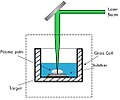Search results
Appearance
There is a page named "Laser ablation synthesis in solution" on Wikipedia
- Laser ablation synthesis in solution (LASiS) is a commonly used method for obtaining colloidal solution of nanoparticles in a variety of solvents. Nanoparticles...5 KB (475 words) - 20:23, 1 June 2023
- lasīs in Wiktionary, the free dictionary. Lasis or LASIS may refer to: Lasi people, an ethnic group of Pakistan LASIS, or Laser ablation synthesis in solution...383 bytes (75 words) - 15:28, 12 March 2022
- fluorescence Laser ablation Laser ablation electrospray ionization Laser ablation synthesis in solution Laser absorption spectrometry Laser accelerometer Laser acronyms...27 KB (2,610 words) - 00:47, 27 February 2025
- are synthesized. Some possible ways to produce ZnO nano-particles are laser ablation, hydrothermal methods, electrochemical depositions, sol–gel method,...7 KB (751 words) - 02:34, 24 September 2024
- material and applied to a metal plate. Second, a pulsed laser irradiates the sample, triggering ablation and desorption of the sample and matrix material. Finally...70 KB (8,255 words) - 15:11, 4 March 2025
- developed to produce carbon nanotubes (CNTs) in sizable quantities, including arc discharge, laser ablation, high-pressure carbon monoxide disproportionation...49 KB (5,797 words) - 09:39, 29 May 2024
- Laser ablation synthesis in solution Laser accelerometer Laser acronyms Laser construction Laser cooling Laser diode Laser diode rate equations Laser...18 KB (2,064 words) - 23:14, 7 October 2024
- Raman spectroscopy (section Lasers)usually from a laser in the visible, near infrared, or near ultraviolet range is used, although X-rays can also be used. The laser light interacts with...86 KB (10,080 words) - 14:09, 8 April 2025
- Ammonia cleaning solution)(2014). "Ammonia-Sensitive Photonic Structures Fabricated in Nafion Membranes by Laser Ablation". ACS Applied Materials & Interfaces. 6 (11): 8903–8908...140 KB (14,987 words) - 18:08, 8 April 2025Erbium (section Lasers and optics)of laser energy is helpful in laser surgery, and for the efficient production of steam which produces enamel ablation by common types of dental laser. A...34 KB (4,239 words) - 03:04, 24 March 2025
- Photothermal ablation)results in the AuNP melting or ablation of the particle. Continuous wave lasers take minutes rather than a single pulse time for a pulsed laser, continues...37 KB (4,593 words) - 09:55, 9 January 2025Copper nanoparticle (section Synthesis)more modern synthesis utilizes copper(II) chloride in a room temperature reaction with sodium citrate or myristic acid in an aqueous solution containing...13 KB (1,389 words) - 09:25, 2 September 2024the use of monodispersed nanoparticles spread in low dilution on the substrate, and the laser ablation of a substrate-catalyst mixture so to form a plasma...17 KB (2,304 words) - 11:18, 22 October 2024Pulsed Laser Deposition has been described in terms of a "snowfall-like" mechanism: (i) Carbon nanoparticles are generated upon laser ablation of a graphite...24 KB (2,744 words) - 03:32, 17 June 2024
- wastes, or garbage and its substitution for gasoline in present-day combustion engines; the laser beam transmission of power and information; the amount
- space-manufacturing processes are imperative. Machine intelligence controlled laser-, electron-, and ion-beam technologies will make possible the highly sophisticated
- membrane) Cytoplasm DNA (hereditary information) Ribosomes for protein synthesis Eukaryotic cells also contain: At least one nucleus Mitochondria for cell
)









